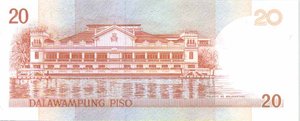|
|
'Malacaņan Palace or (erroneously Malacaņang Palace) is the official residence of the president of the Philippines. The palace is located along the north bank of the Pasig River in Manila. It is called Palasyo ng Malakanyang in Filipino, and Malacaņan Palace when referred to as the official residence of the President of the Philippines, and simply Malacaņang when referred to as the office of the president, as well as in everyday parlance and in the media. Malacaņan Palace is depicted on the verso (back) side of the present-day 20-peso bill.
The Spanish Captains-General (prior to the independence of Mexico, from which the Philippines was directly governed) and then the Governors-General of the Philippines originally resided in the walled city of Intramuros, Manila, until an earthquake leved the Governor's Palace in 1869. At this point, Malacaņang, a summer home originally built in [1802]] by the Rocha family, then subsequently purchased by an official and then purchased by the state, became the temporary residence of the Governors-General Governor General Rafael de Echague y Berminghan, previously governor of Puerto Rico, was therefore the first Spanish governor to occupy Malacaņang.
When the Philippines came under American rule following the Spanish-American War, Malacaņang became the residence of the American Governor-General. In 1900 William Howard Taft became the first American Civil Governor resident. The palace was expanded, and an Executive building added. The complex reverted to the President of the Philippines upon the establishment of the Commonwealth of the Philippines, on November 15, 1935. President Manuel L. Quezon became the first Filipino resident of Malacaņan Palace, and has been the official residence of the President of the Philippines since. After his inauguration on December 30, 1954, President Ramon Magsaysay issued an Executive Order formally changing the name from "Malacaņan Palace" to "Malacaņang: Residence of the President of the Philippines." The new nomenclature rapidly caught on and was maintained until informally abandoned during the Marcos administration. During the administration of President Corazon Aquino, for historical reasons, government policy has been to make the distinction between "Malacaņan Palace", official residence of the president, and "Malacaņang", office of the president.
The palace was made famous as the home of President Ferdinand and Imelda Marcos, who were its longest residents, from 1965 to 1986. As first lady, Mrs. Marcos oversaw the reconstruction of the palace to her own extravagant tastes. Following a student uprising that nearly breached the palace gates in the early 1970's, martial law was declared, and the complex was closed to the public. When President Marcos was deposed in 1986, the palace complex was stormed by the local populace, and the international media subsequently exposed the excesses of the Marcos family, including Mrs. Marcos' famous collection of thousands of shoes.
Today the complex consists of Malacaņan Palace itself, Bonifacio Hall (formerly the Premier Guest House used by Marcos successor Corazon Aquino as her residence and by Joseph Ejercito Estrada as his residence), Kalayaan Hall (the former executive building build under the American administration), Mabini Hall (the Administration Building), and the New Executive Building (built by President Aquino) among other, smaller buildings. Across the river, is Malacaņang Park, which contains a golf course, park, billets for the presidential guard, as well as a Commonwealth-era presidential resthouse (Bahay Pangarap) and recreation hall.
The state and historical rooms of the Palace aren't often seen by the public.While access is much more open than during the martial law years, the Palace is closed and heavily guarded during times of political unrest. Rallyists often congregate along Mendiola Street, nearby to air their protests against the government.es:Palacio Malacaņang

